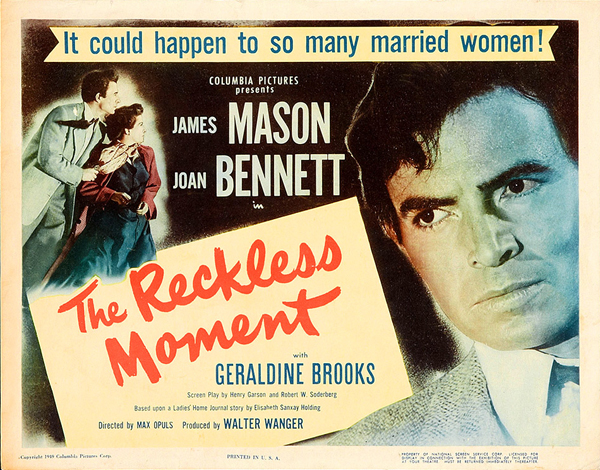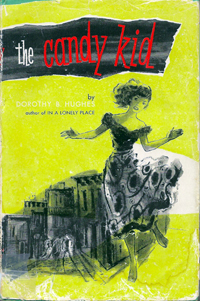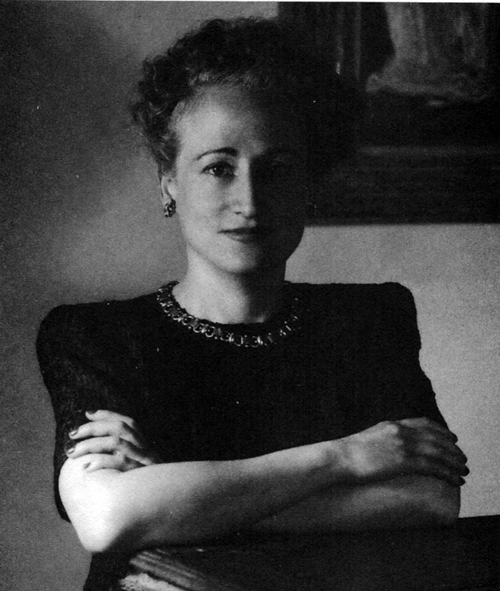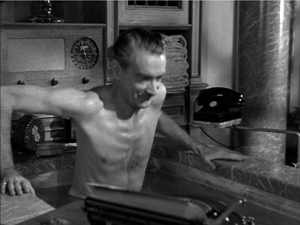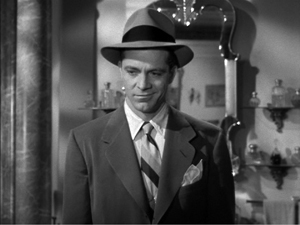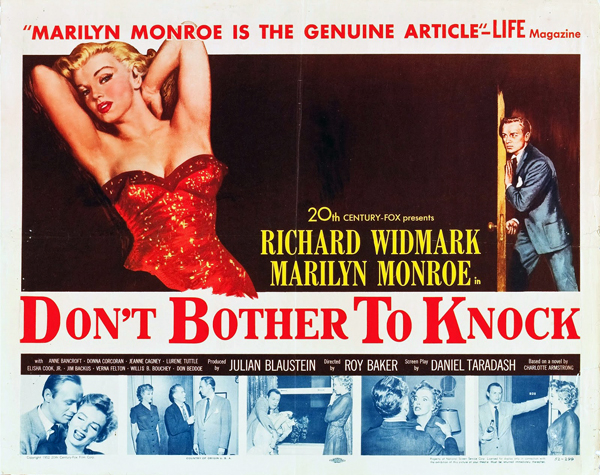DB here:
It’s about time! Sarah Weinman, editor of Troubled Daughters, Twisted Wives [2] (already praised in these precincts [3]) has brought out a two-volume set [4] devoted to women crime writers of the 1940s and 1950s.
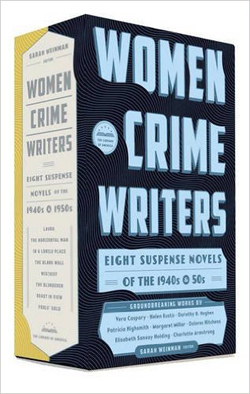 [5]
[5]
It’s not that these authors are utterly unknown. Popular in their day, some retained a following for a few decades, and Patricia Highsmith has become an enduring figure. Yet the never-ending frenzy for male-oriented noir in books and movies has led us to neglect what these writers and their peers accomplished. In the online essay “Murder Culture” [6] I argued that we’ve probably overemphasized the hardboiled detectives and brutalized losers, and we’ve not paid enough attention to the accomplishments of other writers. The rise of the psychological thriller was central to 1940s popular culture.
Granted, it wasn’t only gynocentric. The thriller assumed exciting shapes in the hands of talented men like Patrick Hamilton, Cornell Woolrich and John Franklin Bardin. But the 1940s saw the emergence of a powerful cadre of women writers, many of whom started writing “pure” stories of detection but decided that suspense would be their forte. Surely they were encouraged by the success of Daphne du Maurier’s Rebecca, the best-selling mystery novel before Mickey Spillane came on the scene. But these suspense-mongers avoided mimicking Mignon Eberhart and other predecessors in the innocent-girl-in-a-spooky-house tradition. These new talents saw menace crouching behind the windows of drab houses and apartment blocks. Out of several tendencies I tried to sketch in that essay, they forged a tradition of what Weinman calls “domestic suspense.”
The Library of America volumes give us a fine occasion for appreciating what they accomplished.
Artisans of suspense
You might say that Double Indemnity and Out of the Past are quintessentially 1940s-1950s films, and I’d agree. But other important films were derived from works by women writers. The list of Highsmith adaptations [7], starting with Strangers on a Train (1951), is too long to recite here, but let’s remember that Charlotte Armstrong provided source novels for The Unsuspected (1947) and Don’t Bother to Knock (1952, from Mischief), as well as for Chabrol’s La Rupture (1970) and Merci pour le Chocolat (2000). Filmmakers produced now-classic versions of the Dorothy B. Hughes novels The Fallen Sparrow (1942), Ride the Pink Horse (1946), and In a Lonely Place (1950). The prolific but less famous Elizabeth Sanxay Holding gave us The Blank Wall (1947), adapted twice (The Reckless Moment, 1949, and The Deep End, 2001). Dolores Hitchens’ Fools’ Gold (1958) yielded the implausible basis for Godard’s Band à part (1964). Helen Eustis’s The Fool Killer (1954) became a 1965 film. And of course Vera Caspary’s Laura (1943) became a monument of studio moviemaking.
The thriller, you could argue, makes more engaging cinema than the straight detective story. Much as I admire cinematic sleuths like Sherlock Holmes, Nick Charles, Sam Spade, Philip Marlowe, and particularly Charlie Chan and Mr. Moto [8], pure mystery plots need a lot of bells and whistles to keep from being simply a matter of following the detective as he moves from place to place asking questions and dodging blows on the head. The 1940s tales of espionage, women in peril, serial killings, household anxieties, warped husbands and crazy wives and guileless governesses and all the rest have left a stronger legacy today. We live in the Age of the Thriller, as a glance at any bestseller list will indicate. The recent death of Ruth Rendell, arguably Highsmith’s only top-flight competitor, can only remind us of how the genre has flourished for decades.
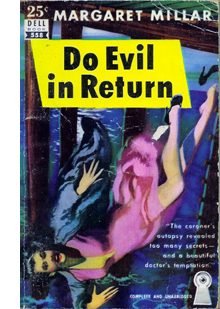 [9]As for the Library of America collection: You couldn’t much improve on Weinman’s selection, I think. All eight novels were appreciated in their day, and some won awards. A reader coming fresh to them will be surprised, I think, by the variety of treatment and the vigor of the writing. It’s to be hoped that encountering these will encourage readers to go on to other works by the same authors. In particular, I’d recommend Sanxay Holding’s The Death Wish (1934), a prefiguration of Highsmith’s dissection of male vulnerability; Margaret Millar’s Do Evil in Return (1950), which centers on a female doctor regretting not helping a woman obtain an abortion; Millar’s chilling The Fiend (1964); and of course almost anything by Dorothy B. Hughes, not least The Expendable Man (1963).
[9]As for the Library of America collection: You couldn’t much improve on Weinman’s selection, I think. All eight novels were appreciated in their day, and some won awards. A reader coming fresh to them will be surprised, I think, by the variety of treatment and the vigor of the writing. It’s to be hoped that encountering these will encourage readers to go on to other works by the same authors. In particular, I’d recommend Sanxay Holding’s The Death Wish (1934), a prefiguration of Highsmith’s dissection of male vulnerability; Margaret Millar’s Do Evil in Return (1950), which centers on a female doctor regretting not helping a woman obtain an abortion; Millar’s chilling The Fiend (1964); and of course almost anything by Dorothy B. Hughes, not least The Expendable Man (1963).
The Library of America collection has rounded up several contemporary purveyors of suspense to write brief online appreciations [10] of the titles in the collection. These are well worth reading. On each page further links take you to fresh material. There’s also a succinct introduction [11] by Weinman. The print editions include her judicious career summaries, as well as notes on allusions and citations in each novel.
For readers interested in how women’s cultural roles are represented in fiction, these books provide a field day. Several of the professional commentaries suggest that the authors injected social criticism into their works. These writers are far more willing to get inside men’s heads than the hard-boiled boys are to think like a woman, so you can see the macho attitude in a new light. Here’s how Dorothy B. Hughes in The Candy Kid (1950, not in this collection) describes her hero:
Just as he was thinking that he’d better go in and buy a pack, wait for Beach in the air-cooled coffee shop, the girl came around the corner. She was tall, almost as tall as he, but he took a quick look at the pavement and saw that she was propped on heels. That made him feel more male.
Very often these writers take certain stereotypes, both male and female, and submit them to pressure through their craft. Others seem to accept those stereotypes and employ them for their own storytelling ends. Those ends are very much worth our attention.
We know that several of these writers were self-conscious artisans. Hughes and Armstrong wrote articles reflecting on mystery and suspense, while Hughes also wrote a sharp biography [13] of Erle Stanley Gardner. Hughes also conducted a course on mystery writing at UCLA in the 1960s; she invited Vera Caspary in for a guest lecture, and Caspary’s advice makes for fascinating reading. Highsmith’s notebooks, preserved at the Archives littéraires in Switzerland, are filled with meditations on story problems, and she wrote as well a book-length manual, Plotting and Writing Suspense Fiction [14] (1966, 1981). I don’t think that any hard-boiled writers of the era have left such systematic reflections on the nuts and bolts of their work.
Once we pay attention to technique, we can see how these writers rework topics and concerns of the day. For example, we could talk a long time about how social roles induce women to assume a split identity: one face for friends and family, another that resists the masquerade. But these, after all, are mysteries, so that divided identity has to be dramatized—or better yet, played with and teased out for the sake of suspense and surprise. It’s remarkable that two of the books in the collection exploit the syndrome of Multiple Personality Disorder, which becomes part of the final surprise. Another, Laura, makes an enigma of the woman’s inner life by virtue of dispersed viewpoints.
If we want to learn about storytelling, we can usefully look at how writers manage traditional demands of craft. These books “say what they say” in and through technique—narrative form, literary style. The experience that results can be an enduring achievement.
Pronoun trouble
No use asking if the crime writer has anything of the criminal in him. He perpetuates little hoaxes, lies and crimes every time he writes a book.
Patricia Highsmith
Start with style—important in all storytelling, but posing some fascinating issues in the domestic thriller.
One problem faced by all these writers was: How to avoid the sentimental style of romantic suspense writers? Here’s a typical passage from Mignon G. Eberhart’s Another Woman’s House (1946).
She said, blindly choosing trite and inadequate words, “You cannot change your own sense of loyalty, of your own creed and code. It’s bred in your bone; it’s part of your body.”
He understood all the argument below it. He understood too that it was a fundamental argument in his own heart. His eyes deepened, searching her own. He said suddenly, “Myra, you must see this sensibly; you must be realistic and . . .”
“Oh, Richard, Richard!” She cried despairing, and put her head against his shoulder.
There’s some of this novelettishness in Armstrong, as in this bit from Mischief:
When a fresh scream rose up, out there in the other room in another world, Ruth’s fingertips did not leave off stroking into shape the little mouth that the wicked gag had left so queer and crooked.
Hughes and Hitchens, I think, leaned toward the hardboiled laconicism of Hammett and Cain, though without the slanginess. In The Horizontal Man, Eustis tries for a brittle, satiric tenor and some Hollywoodish banter between a reporter and a college woman. Highsmith was adamant in refusing what she called a “pulp” style. Hence her flat, spare simplicity. (Funny, though, since she started out writing comic books for the company that would become Marvel.)
Stylistic options can lie very far down. For years I’ve been curious about what fiction writers call their characters on first entrance. It’s a fundamental creative choice, and it’s absolutely forced: you have to call them something. And what you call them matters.
Here’s the beginning of Armstrong’s Mischief:
A Mr. Peter O. Jones, the editor and publisher of the Brennerton Star-Gazette, was standing in a bathroom in a hotel in New York City, scrubbing his nails. Through the open door, his wife, Ruth, saw his naked neck stiffen….
Cozy, our relation to this Mr. and Mrs. Jones: Mischief gives their first and last names. So far, no reason to be apprehensive. But here’s the start of Hitchens’ Fools’ Gold:
The first time they drove by the house Eddie was so scared he ducked his head down. Skip laughed at him.
Here a relationship is defined through laconic action: we’re on a first-name basis with the pair. It’s as if we’re riding in the back seat. 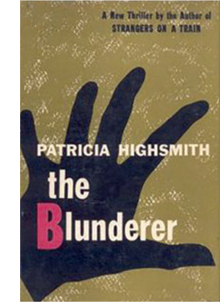 [15]Compare the opening of Highsmith’s The Blunderer.
[15]Compare the opening of Highsmith’s The Blunderer.
The man in the dark blue slacks and a forest green sportshirt waited impatiently in the line.
The girl in the ticket booth was stupid, he thought, never had been able to make change fast.
Highsmith is more ominous: No names, just a man as if seen from across the sidewalk. Yet we can’t say the presentation is “objective” because we’re given his annoyed thoughts about the ticket girl. So we are forced to ask: If I’m in his head, why don’t I know who he is? And why is he in a hurry?
And finally, the opening lines of Eustis’ The Horizontal Man:
The firelight played over all the decent, familiar objects of his everyday life; he viewed them desperately, looking for some symbol of succor. The firelight played on his rolling eyeballs, the careless tendrils of his black hair. “Oh now,” he said, “Oh now, I say, look here…” trying to summon a tone of commonplace to breast the tide of nightmare that was rising in that room.
Eustis dispenses with everything but he in describing something terrible going on. Not only do we not know who’s suffering, but we won’t know for some time. This, like the Highsmith, might be called “pronominal mystery”: not knowing anything about who’s in danger, we sense the danger as a pure force swallowing up trivialities of identity.
Most manuals of fiction-writing start by reviewing the bigger choices, like first- or third-person narration, but note that even within third-person storytelling, these passages bristle with different implications. Each of these openings puts us in a different relation to the characters picked out.
The storyteller makes a choice about how to name the actors in the scene, and that choice leads to others: the scene is built out the premises of what have launched it. Ruth, who studies her husband Peter at the mirror, will become one conduit of information within Mischief. Skip, who laughs at Eddie as they size up the home they’ll invade, will bully his partner throughout Fools’ Gold. The man in the slacks and sportshirt will drop out of The Blunderer for several chapters. So no need to name him yet; magnify the mystery. And the opening scene of The Horizontal Man will continue with personal but untagged pronouns—a she will be picked out too—as the full awfulness of the action emerges.
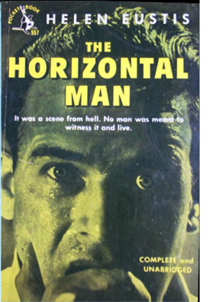 [16]I suspect that the development of the suspense thriller in the 1940s sensitized writers to fine-grained choices like this. The verbal fabric became part of the suspense: not just what will happen next? but why is the action being presented in this way? This second layer of intrigue seldom occurs in the hardboiled detective novels. While Hammett, Chandler, and Ross Macdonald (married to Margaret Millar) slipped easily into first person and easygoing openings, these women writers were willing to try more oblique, tantalizing, and formally adventurous options. (Though we find them in Goodis, Woolrich et al. as well.) Without this newly cultivated sensitivity to names and non-names, proper nouns and pronouns, I doubt we would have the tour de force of Ira Levin’s A Kiss Before Dying (1953) and the shock of Hughes’ Expendable Man, or the brilliant opening of Ruth Rendell’s Wolf to the Slaughter (1967).
[16]I suspect that the development of the suspense thriller in the 1940s sensitized writers to fine-grained choices like this. The verbal fabric became part of the suspense: not just what will happen next? but why is the action being presented in this way? This second layer of intrigue seldom occurs in the hardboiled detective novels. While Hammett, Chandler, and Ross Macdonald (married to Margaret Millar) slipped easily into first person and easygoing openings, these women writers were willing to try more oblique, tantalizing, and formally adventurous options. (Though we find them in Goodis, Woolrich et al. as well.) Without this newly cultivated sensitivity to names and non-names, proper nouns and pronouns, I doubt we would have the tour de force of Ira Levin’s A Kiss Before Dying (1953) and the shock of Hughes’ Expendable Man, or the brilliant opening of Ruth Rendell’s Wolf to the Slaughter (1967).
Fussy as these details are, they’re what I mean by craft. The verbal texture of any piece of fiction depends on dozens of such minute judgments. Just as in film every cut, camera movement, and actor’s glance matters, so does every word in a prose narrative. These writers understood that what we learn, syllable by syllable, can be a potent source of uncertainty and suspense.
Who sees and who knows?
The whole intricate question of method, in the craft of fiction, I take to be governed by the question of the point of view—the question of the relation in which the narrator stands to the story.
Percy Lubbock, The Craft of Fiction
In mystery fiction, management of point of view is critical. Not only will it weave the moment-by-moment verbal tissue, but it provides the large-scale parts that present the overall action. Where the Had-I-But-Known romance tends to be restricted to a single character, often through first-person narration, domestic suspense employs other options. It’s significant that of these eight novels, only one, Laura, employs first-person narration, and that in a distinctive way I’ll consider further along.
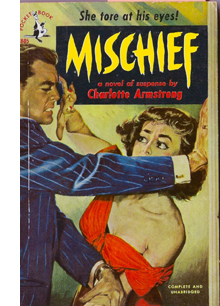 [17]Unrestricted narration is a good strategy for maximizing suspense, as we see in Armstrong’s Mischief. A husband and wife leave their little girl with a babysitter in their hotel while they go off to an awards dinner. But the babysitter is one of those Crazy Ladies that the 40s produce in great profusion and the child is endangered.
[17]Unrestricted narration is a good strategy for maximizing suspense, as we see in Armstrong’s Mischief. A husband and wife leave their little girl with a babysitter in their hotel while they go off to an awards dinner. But the babysitter is one of those Crazy Ladies that the 40s produce in great profusion and the child is endangered.
How to complicate this basic situation? Armstrong recruits a device—call it a narrative meme if you want—that emerges at the period: the eyewitness, typically in an urban setting, who glimpses possibly criminal doings and gets involved. This device finds its supreme filmic expression in Rear Window (1954), but it’s established in earlier films like Lady on a Train (1945), Shock (1946), and The Window (1949), and in the radio drama The Thing in the Window [18] (1945), by Lucille Fletcher (another thriller queen, but of the airwaves). In Mischief, people in a building across the street from the hotel intervene in the doings of the babysitter, and the plot “intercuts” all their trajectories in order to create tension.
Hitchens’ Fools’ Gold similarly jumps from character to character, even within a single scene. This tale of a heist that is way above the skill sets of the thieves—a sort of humorless anticipation of an Elmore Leonard or Donald Westlake situation—uses unrestricted narration to build sympathy for the characters who are gulled into participating.
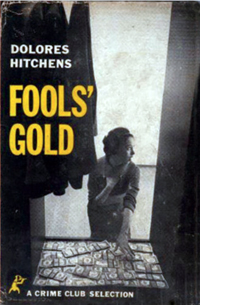 [19]Central among these is Karen, pathetically happy that Skip is paying attention to her. One chapter starts with her meeting him after class, snuggling warmly into his arms (“Here was someone to whom she could confide the disaster with the coat”), before the narration switches brusquely to him:
[19]Central among these is Karen, pathetically happy that Skip is paying attention to her. One chapter starts with her meeting him after class, snuggling warmly into his arms (“Here was someone to whom she could confide the disaster with the coat”), before the narration switches brusquely to him:
Skip listened, at first with indifference. He’d heard already from Eddie of Karen’s reaction to the money, her frightened excitement about it. It took a moment to realize that this wasn’t more of the same, the reaction of an inexperienced girl, but that a bad break had really occurred.
Throughout the chapter, this rather nineteenth-century version of omniscience will toggle between Karen and Skip, heightening the disparity between her lack of awareness and his harshness. “He was just having fun though she didn’t know it.” Arguably, a heist plot needs a certain wide-ranging narration (see The Asphalt Jungle), but Hitchens uses it to take us into the minds of all the characters, major and minor, and suggest both vulnerability and menace.
In a classic detective story, the identity of the culprit is concealed until the end. One Golden Age “rule” is that in the course of the action we must never be given the viewpoint of the killer. The rule was broken on occasion, notably in a certain novel by Agatha Christie, but it remained rather firm. In the thriller, by contrast, we can be in the killer’s mind, knowing full well that he or she is indeed the killer. A prototype is Patrick Hamilton’s Hangover Square (1941). Two books in this collection walk a line between detective story and thriller in this respect.
In Eustis’ The Horizontal Man, a popular professor has been murdered. The effects of his death ripple out across the campus, and the narration shifts among his colleagues, some students, and a reporter investigating the crime. In the midst of a corrosive satire of the academic life, we suspect that someone whose mind we have entered will turn out to be the culprit. So we have to probe the inner lives of the characters we encounter for psychological clues, not physical ones. The author must conceal the killer’s identity and “play fair,” in that what we learn at the end unexpectedly fits the characters’ stream-of-consciousness musings.
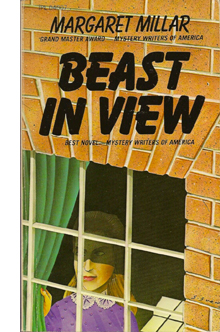 [20]A similar problem confronts Margaret Millar in Beast in View. At the start the viewpoints aren’t quite so dispersed: initially, we shift between a woman plagued by threatening phone calls and an amateur investigator looking into the matter. As the mystery deepens, however, the range of knowledge spreads and we get “lateral” viewpoints on the central situation. This is partly to deflect us from the grim revelation that we have been quite thoroughly misled.
[20]A similar problem confronts Margaret Millar in Beast in View. At the start the viewpoints aren’t quite so dispersed: initially, we shift between a woman plagued by threatening phone calls and an amateur investigator looking into the matter. As the mystery deepens, however, the range of knowledge spreads and we get “lateral” viewpoints on the central situation. This is partly to deflect us from the grim revelation that we have been quite thoroughly misled.
It is a pity that this edition didn’t include Millar’s 1983 Introduction and Afterward. The latter explains the origin of the book’s device, while the Introduction reports the effects the book had:
I was threatened with a libel suit, informed by a patient in a mental institution that at last she had found someone who really understood her, invited to join a coven of witches, asked to address a meeting of psychiatric social workers, and presented with the Mystery Writers of America Edgar Allan Poe award for best mystery of the year.
At the other extreme, two of these novels focus on extremely restricted viewpoints. Hughes’ In a Lonely Place is wholly locked within the mind of a hypermasculine ex-Air Force pilot who trails and murders women. Hughes gives us the pronominal tease: it’s he for the first five pages until, when he places a phone call, we learn he’s called Dix Steele. In a cat-and-mouse game reminiscent of films like Woman in the Window and Where the Sidewalk Ends, the killer gets close to the murder investigation. Dix’s army buddy is the chief cop on the case, so Dix can monitor things and even drop in on crime scenes. Strikingly, Hughes puts the killings “off-page.” This admirably eliminates any Spillane-ish sensationalism while keeping the focus wholly on the way Dix loses control of his masquerade. He’s worn away in a series of confrontations with two women who see, as no man can, something deeply wrong in him.
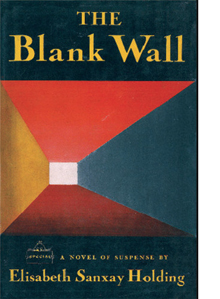 [21]Closest to the traditional woman-in-peril plot is Sanxay Holding’s The Blank Wall. While her husband is away in the service, a middle-class housewife learns that her daughter has been seduced by a sleazy opportunist. The wife soon becomes the target of two blackmailers, one of whom grows to love her. Gifted with a pair of obnoxious and ungrateful children and an amiably oblivious father, the heroine is doubly trapped—within a confining household and a crime cover-up. We’re limited to her range of knowledge, so every encounter is charged with uncertainty about the motives of others. She can’t confide in her husband and so must write bland letters to him reporting that everything is just fine.
[21]Closest to the traditional woman-in-peril plot is Sanxay Holding’s The Blank Wall. While her husband is away in the service, a middle-class housewife learns that her daughter has been seduced by a sleazy opportunist. The wife soon becomes the target of two blackmailers, one of whom grows to love her. Gifted with a pair of obnoxious and ungrateful children and an amiably oblivious father, the heroine is doubly trapped—within a confining household and a crime cover-up. We’re limited to her range of knowledge, so every encounter is charged with uncertainty about the motives of others. She can’t confide in her husband and so must write bland letters to him reporting that everything is just fine.
As you’d expect, Highsmith tries something more intricate in The Blunderer. Here we have two protagonists, each man given his own viewpoint. But after an opening introducing us to one man’s crime (in a scene that spares no violent detail), he drops out of the action for a hundred pages. We concentrate instead on the polished professional lawyer whose life unravels when his domestic skirmishes—nearly all petty and drab—come to a head. As with most Highsmith men, he is tempted to do something very trivial and very stupid, almost out of intellectual curiosity. Highsmith policemen take a dim view of such enacted thought experiments.
As the two protagonists’ worlds converge, we get the characteristic Highsmith themes of self-possessed men losing their nerve, the traps of respectable life, the risk of impulsive action, the ways in which friends turn away from you when they suspect you of lying. The lawyer is called by his first name, Walter, while his counterpart is known to us by his last name, Kimmel. In such subtle ways does an author align us a little more closely with one character than another. Both, though, are blunderers.
I should add that all the markers of 1940s fiction and film—dreams, hallucinations, false fronts, unstable families, untrustworthy lovers, socially adroit psychopaths—are woven into these novels with great skill. What more could you ask?
A frenzy of recapitulation
Vera Caspary, 1946.
The earliest novel in Weinman’s collection is also one of the most remarkable of the period. Vera Caspary was a woman to be reckoned with—Greenwich Village free-love practitioner, Communist party member, occasional screenwriter, boundlessly energetic purveyor of suspense fiction, passionate paramour of a married man, and advocate for women in prison. Our State Historical Society holds her personal collection, which includes fascinating notes on projects both realized and unrealized. Turning the pages of her files, you meet a crisp, professional artisan.
So let’s look at Laura the novel. If you know the film, as you probably do, nothing I say will spoil the book for you.
In 1942 Collier’s (“The National Weekly”) offered Caspary $10,000 for the serial rights to Ring Twice for Laura. That sum, equal to $150,000 today, didn’t include book publishing rights, movie rights, and any other ancillaries. The price tag tells us quite a bit about the robust slick-magazine market of the period and about Vera Caspary’s standing. After writing novels, plays, short stories, and screenplays, she was no novice, but her new manuscript set her on a path toward fame. Published as Laura in 1943, it found acclaim as “something quite different from the run-of-the-mill detective story.” The publisher called it a “psychothriller.”
Laura is both a mystery story and a romance. A woman is found murdered in her apartment. Although a shotgun blast has disfigured her face, she’s initially identified as ad executive Laura Hunt. After the funeral, while detective Lieutenant Mark McPherson is poking around her apartment, Laura returns from a trip and it’s revealed that the victim was actually Diane Redfern, a model to whom Laura had loaned the apartment.
The misidentified-victim convention triggers an investigation into the usual sort of suppressed backstory: How did Diane wind up in Laura’s place? Was she alone? Was she the target all along, or was she mistaken by the killer for Laura? Along the way, the cop—already half in love with Laura dead—begins to both woo and browbeat her.
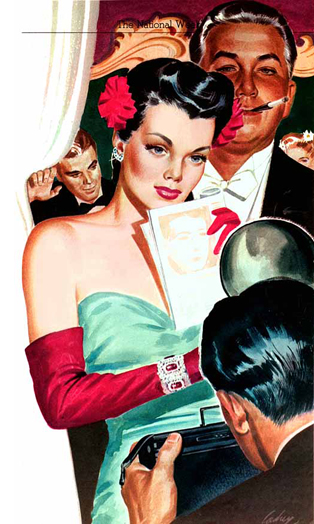 [23]At the same time, a cluster of suspects needs questioning: Laura’s flighty Aunt Susie, her fiancé Shelby Carpenter, and her lordly patron, the columnist Waldo Lydecker. Laura isn’t exonerated either, because she has reason to hate Diane. The usual array of clues—the murder weapon, a bottle of cheap bourbon, and a cigarette case—tugs McPherson this way and that, although his final discovery of the killer depends as much on intuition about personality as about physical traces. The plot hole in the film (why isn’t the artist Jacoby, who painted Laura’s portrait, an obvious suspect?) is there in the original novel as well, but few readers or viewers seem to notice it.
[23]At the same time, a cluster of suspects needs questioning: Laura’s flighty Aunt Susie, her fiancé Shelby Carpenter, and her lordly patron, the columnist Waldo Lydecker. Laura isn’t exonerated either, because she has reason to hate Diane. The usual array of clues—the murder weapon, a bottle of cheap bourbon, and a cigarette case—tugs McPherson this way and that, although his final discovery of the killer depends as much on intuition about personality as about physical traces. The plot hole in the film (why isn’t the artist Jacoby, who painted Laura’s portrait, an obvious suspect?) is there in the original novel as well, but few readers or viewers seem to notice it.
What was striking about the book was its point-of-view structure. “Four persons tell this story and play the leading parts in it,” noted the New York Times reviewer. “McPherson questions all three, and all three tell him lies.” In presentation Caspary revived what has been called the casebook method of composition: a series of testimonies, written or transcribed from speech, that recount the mystery. Sometimes those are accompanied by police reports, newspaper coverage, and other documents.
The method is identified with Wilkie Collins’ two great novels The Woman in White (1860) and The Moonstone (1868), and was taken up occasionally by others, particularly within a trial situation (e.g., The Bellamy Trial, 1929). Before Laura, probably the most famous instance of a mystery collation is Dorothy Sayers and Robert Eustace’s Documents in the Case (1930). The technique also has affinities with multiple-viewpoint assembly in “straight” fiction influenced by Dos Passos; Kenneth Fearing had tried it in his experimental novels The Hospital (1939) and Clark Gifford’s Body (1942) as well as in his crime stories Dagger of the Mind (1941) and The Big Clock (1946).
To take us through the eight days of the investigation, Caspary’s casebook assigns each character a block of narration. Each block, told in first person, has its own distinctive tenor, representing a particular subgenre of mystery fiction.
If you didn’t know the Laura mystique already, you might suspect that the opening chunk, told from Waldo’s perspective, would announce him as the brilliant amateur detective who will solve the case and surpass the plodding McPherson. Waldo is a celebrity columnist, a connoisseur of murder and lethal banter. Like 1920s detective Philo Vance, he collects art and lords it over others through aggressive erudition. Waldo writes in periodic sentences of eloquent self-congratulation:
My grief in her sudden and violent death found consolation in the thought that my friend, had she lived to a ripe old age, would have passed into oblivion, whereas the violence of her passing and the genius of her admirer gave her a fair chance at immortality.
There are even the sort of fake footnotes that we find in S. S. Van Dine and Ellery Queen novels of the 1930s, attesting to the scholarly bona fides of this dilettante sleuth.
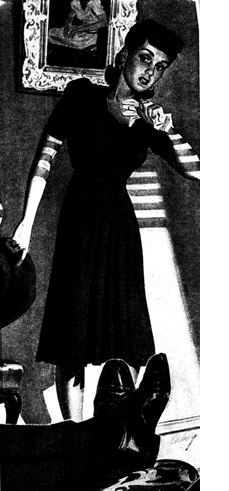 [24]Waldo’s power over Laura, as her patron and guru, gets expanded to a remarkable authority over the narrative in this first part. He tells us things he did not witness, chiefly the early “offstage” phases of McPherson’s investigation, and his explanation is that of the artist as god.
[24]Waldo’s power over Laura, as her patron and guru, gets expanded to a remarkable authority over the narrative in this first part. He tells us things he did not witness, chiefly the early “offstage” phases of McPherson’s investigation, and his explanation is that of the artist as god.
That is my omniscient role. As narrator and interpreter, I shall describe scenes which I never saw and record dialogues which I did not hear. For this impudence I offer no excuse. I am an artist, and it is my business to re-create movement precisely as I create mood. I know these people, their voices ring in my ears, and I need only close my eyes and see characteristic gestures. My written dialogue will have more clarity, compactness, and essence of character than their spoken lines, for I am able to edit while I write, whereas they carried on their conversation in a loose and pointless fashion with no sense of form or crisis in the building of their scenes.
This is an extraordinary passage. It opens the very-‘40s possibility that what follows may be Waldo’s fantasy. Only near the end of his text does Waldo assert that his knowledge of McPherson’s investigation is derived from what Mark later told him one night at dinner. We will soon learn that Waldo’s opening section was written directly after that dinner, but he actually didn’t know one key fact. His omniscience is an illusion.
McPherson takes up the tale in the second part. He has read Waldo’s account and treats it as a separate piece of evidence. As we follow McPherson’s investigation, we’re in the realm of the police procedural. The register shifts too. If Waldo’s style is showoffish, McPherson’s is laconic. Whereas Waldo celebrates how his prose will immortalize Laura, McPherson admits that his version of things “won’t have the smooth professional touch.”
Actually, though, it does. It reads hard-boiled.
As we stepped out of the restaurant, the heat hit us like a blast from a furnace. The air was dead. Not a shirt-tail moved on the washlines of McDougal Street. The town smelled like rotten eggs. A thunderstorm was rolling in.
Caspary gives us the voice of the tough but vulnerable cop, the voice we would later learn to call noir. There’s an echo of James M. Cain when McPherson signals that in retrospect he was wrong to trust this femme fatale: he sourly describes himself in the third person.
She offered her hand.
The sucker took it and believed her.
McPherson’s eventual victory over Waldo is prefigured in the cop’s reflections on writing up crime. When Waldo learned Laura was still alive, McPherson says, “The prose style was knocked right out of him.” So much for Wimseyish fops set down in a Manhattan murder.
Shelby gets his voice in as well. A brief third section consists of a police transcript of McPherson’s questioning. Aided by his attorney, Shelby withdraws some lies, dodges uncomfortable areas, and generally remains the most obvious suspect—as well as Mark’s rival for Laura. At this point in the book Caspary begins to play an intricate game of knowledge, in which we get, piecemeal, information that tests the string of deceptions and evasions confronting McPherson.
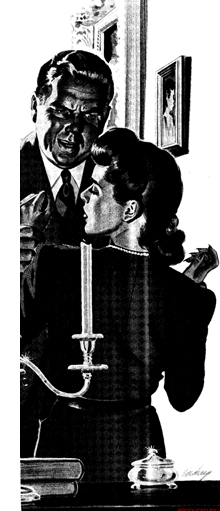 [25]In the fourth section, Laura writes her testimony. Once more the circumstance of composition is explained to us. Laura confesses that she can’t understand what she thinks and feels unless she sets it down. She has burned her old diaries, but now she has to start over.
[25]In the fourth section, Laura writes her testimony. Once more the circumstance of composition is explained to us. Laura confesses that she can’t understand what she thinks and feels unless she sets it down. She has burned her old diaries, but now she has to start over.
It’s always when I start on a long journey or meet an exciting man or take a new job that I must sit for hours in a frenzy of recapitulation.
Now the action is that of the woman in peril, the figure familiar from Eberhart and Rinehart and Sanxay Holding. And so the stylistic register is “feminine,” tracking fluctuations of feeling and noting costume details and shades of color. Laura’s narration is also suspenseful and contemplative, dwelling on moments that seem to radiate danger—McPherson’s trick questions, Waldo’s sinister manipulations, and Shelby’s pretense that he’s protecting her rather than himself.
The emphasis is less on external behavior than Laura’s growing realization of why she has clung to two failed men. She will gradually realize that McPherson, despite his coldness, is the best match for her. Waldo is “an old lady” and Shelby is an overgrown baby. Caspary the left-winger gives these portraits the taint of class corruption. Waldo and Shelby are ghoulish creatures of the high life, while Aunt Susie is the faded, self-indulgent beauty Laura might become.
Laura’s recognition of her entrapment is rendered in a choppy, spasmodic fashion. Waldo’s, McPherson’s, and Shelby’s accounts have all been linear. Laura’s is not. It skips around in time, replays scenes we’ve seen from other viewpoints, and incorporates dreams that seem as well to be flashbacks.
This is no way to write the story. I should be simple and coherent, fact after fact, giving order to the chaos of my mind. . . . But tonight writing thickens the dust. Now that Shelby has turned against me and Mark shown the nature of his trickery, I am afraid of facts in orderly sequence.
In a narrative dynamic we find throughout 1940s fiction and film, the strong career woman is thrown off balance and succumbs to confusion. The most notorious example is of course Lady in the Dark, the 1941 play that appeared on film in 1944, the same year as the film version of Laura.
The lady returned from the dead will need a real man to rescue her. That rescue is enacted, again, in prose when McPherson reassumes control of the narrative. The book’s fifth part consists of two sections: the classic summing up and denunciation of the culprit (Waldo) and the rescue of Laura from Waldo’s second attempt to kill her. McPherson’s hard-boiled diction has won out. As Waldo is taken away in the ambulance, however, he earns a degree of purely verbal revenge. McPherson’s narration quotes Waldo’s mumbled phrases as, dying, he fills in plot points. In the process, his style gets inserted, like an alien bacterium, into McPherson’s curt passages.
McPherson, who can afford to be gallant, gives Waldo the last convoluted word. It comes in a quotation from the manuscript found by McPherson at the climax, a passage that confirmed Waldo’s guilt. In Waldo’s unfinished account, Laura is an essence of womanhood, a modern Eve; but one who continually reminded him that he could never be Adam.
During production of the film version of Laura, the makers considered mimicking the novel’s block construction. Citizen Kane had made multiple-viewpoint narration more thinkable in the 1940s. In the end, though, only Waldo’s voice-over was retained, with results that have provoked several critical comments.
The film made many other changes, large and small, but during this reading of the novel two improvements stood out for me. Making Waldo a radio commentator as well as a columnist allows a rich play of sound that comes to a climax at the film’s dénouement. Secondly, Waldo drops out of the book for many stretches, largely because Caspary is concerned to throw suspicion on Shelby and Laura. But the film keeps Waldo onscreen a lot, even permitting him (against all plausibility) to tag along with McPherson on the investigation. His waspish interjections, delivered by a suave Clifton Webb, add a nice tang, while sustaining Caspary’s theme of class snobbery. The film adds several kinks, such as introducing Waldo writing in his bathtub. The situation includes one of those how-did-they-get-away-with-it? moments when, as Waldo climbs out of the water, Mark glances scornfully offscreen at Waldo’s privates.
Caspary would go on to other successes, notably the screenplays for A Letter to Three Wives (1948) and Les Girls (1957) and several other novels that play with block construction and shifting viewpoints. But Laura would remain her prime achievement. It’s a striking novel that became a landmark film and an enduring example of how female crime novelists could stretch and deepen the conventions of popular literature.
A useful and spoiler-free biographical survey of many of these writers is Jeffrey Marks’ Atomic Renaissance: Women Mystery Writers of the 1940s and 1950s [28] (Delphi, 2003). See Mike Grost’s inevitably encyclopedic coverage [29] as well.
Highsmith’s disdain for pulpish style is discussed in Andrew Wilson, Beautiful Shadow: A Life of Patricia Highsmith [30] (Bloomsbury, 2003), p. 124; my quotation above comes from p. 256. I’m grateful to Ms. Stéphanie Cudré-Mauroux of the Archives littéraires suisses for other information about Highsmith.
Some craft advice from these authors can be found in Dorothy B. Hughes, “The Challenge of Mystery Fiction,” The Writer 60, 5 (May 1947), 177-179; Charlotte Armstrong, “Razzle Dazzle,” The Writer 66, 1 (January 1953), 3-5; and Patricia Highsmith, “Suspense in Fiction,” The Writer 67, 12 (December 1954), 403-406. Millar’s discussion of Beast in View is in the International Polygonics edition [31] of the novel, 1983, pp. 1-2, 249.
Vera Caspary’s autobiography, The Secrets of Grown-Ups [32] (New York: McGraw-Hill, 1979), is a captivating read that introduces us to a fascinating personality. (“Under the ready smiles were witches’ grimaces, beneath the padded bra a calcified heart.”) In Wilkie Collins, Vera Caspary and the Evolution of the Casebook Novel [33] (McFarland, 2011) A. B. Emrys offers an excellent study of Caspary’s work in relation to mystery traditions. Caspary’s “official” response to Preminger’s film comes in “My Laura and Otto’s,” [34]Saturday Review (26 June 1971), 36-37.
Hammett was no slouch at juggling proper names and pronouns either. I marvel that he could call Ned Beaumont “Ned Beaumont” all the way through The Glass Key. All the other characters are tagged with their first or last name, but this option maintains an unsettling middle distance on his psychologically opaque protagonist.
I discuss Waldo’s narration in the film version of Laura in more detail in this entry [35].
